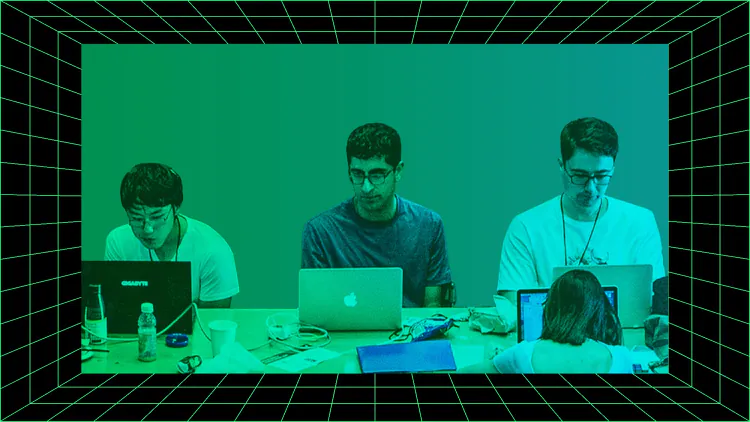The Wrong Way to Study AI in College
Computer-science students are being shielded from the liberal arts. That may be a problem.

This is Atlantic Intelligence, a limited-run series in which our writers help you wrap your mind around artificial intelligence and a new machine age. Sign up here.
Earlier this week, my colleague Ian Bogost published a provocative article about a trend in higher education: the opening of distinct colleges of computing, akin to law schools. New programs at MIT, Cornell, and soon UC Berkeley follow an uptick in the number of students graduating with computer-science majors. They are serving a growing market.
“When they elevate computing to the status of a college, with departments and a budget, they are declaring it a higher-order domain of knowledge and practice,” Ian writes. “That decision will inform a fundamental question: whether computing ought to be seen as a superfield that lords over all others, or just a servant of other domains, subordinated to their interests and control. This is, by no happenstance, also the basic question about computing in our society writ large.”
This talk of subordination naturally turned my mind toward AI, a technology that some believe threatens to upend the world as we know it. If students pursue majors in AI within the isolated confines of a college of computing—without the grounding of a broader arts-and-science education—how can we expect them to make wise decisions about how that technology is applied? I asked Ian for his thoughts.
“We generally don’t use computers just for computing—the computing does something,” he told me. “AI is a term without real meaning; in some ways, it’s just a nickname for a certain intensification of automation that’s been ongoing for years. But one of the promises, or threats, of AI is that it can apply computing problem-solving to many more domains, and very effectively. So if computer people do, in fact, know less about everything in the world beyond computing while simultaneously building or applying AI to many more problem spaces, and faster, too, then that seems like it could be quite concerning indeed.”
But the risk, such as it is, extends in two directions. The “computer people” might be missing out on the liberal arts, but so, too, are the liberal-arts people missing out on computer science. “If people with domain expertise insist on simply resisting AI as an unwelcome incursion, one that can be fought, they also risk ceding their opportunity to influence how computing might colonize their efforts,” Ian said. “It seems naive to think that it just won’t, that the ‘enemy’ can be held off at the gates forever—or even that it’s an enemy you’d want to hold off.”
— Damon Beres, senior editor

Universities Have a Computer-Science Problem
By Ian Bogost
Last year, 18 percent of Stanford University seniors graduated with a degree in computer science, more than double the proportion of just a decade earlier. Over the same period at MIT, that rate went up from 23 percent to 42 percent. These increases are common everywhere: The average number of undergraduate CS majors at universities in the U.S. and Canada tripled in the decade after 2005, and it keeps growing. Students’ interest in CS is intellectual—culture moves through computation these days—but it is also professional. Young people hope to access the wealth, power, and influence of the technology sector.
That ambition has created both enormous administrative strain and a competition for prestige. At Washington University in St. Louis, where I serve on the faculty of the Computer Science & Engineering department, each semester brings another set of waitlists for enrollment in CS classes. On many campuses, students may choose to study computer science at any of several different academic outposts, strewn throughout various departments. At MIT, for example, they might get a degree in “Urban Studies and Planning With Computer Science” from the School of Architecture, or one in “Mathematics With Computer Science” from the School of Science, or they might choose from among four CS-related fields within the School of Engineering. This seepage of computing throughout the university has helped address students’ booming interest, but it also serves to bolster their demand.
What to Read Next
- Elon Musk just added a wrinkle to the AI race: “Transparency, or the appearance of it, is the technology’s new norm,” Matteo Wong writes.
- The AI industry is stuck on one very specific way to use a chatbot: “OpenAI, Google, and Microsoft are dying to help plan your next trip,” Caroline Mimbs Nyce writes.
- Whatever happened to all those care robots?: “So far, companion robots haven’t lived up to the hype—and might even exacerbate the problems they’re meant to solve,” Stephanie H. Murray writes.
P.S.
I spotted a new Coca-Cola flavor at the grocery store earlier this week—“raspberry spiced”—and had a flashback to September, when the company unveiled a formula that was purportedly made with the help of artificial intelligence. “It smells like circus-peanut candies and tastes mostly like Coke,” my colleague Kaitlyn Tiffany wrote at the time. Bottoms up.
— Damon
What's Your Reaction?




















